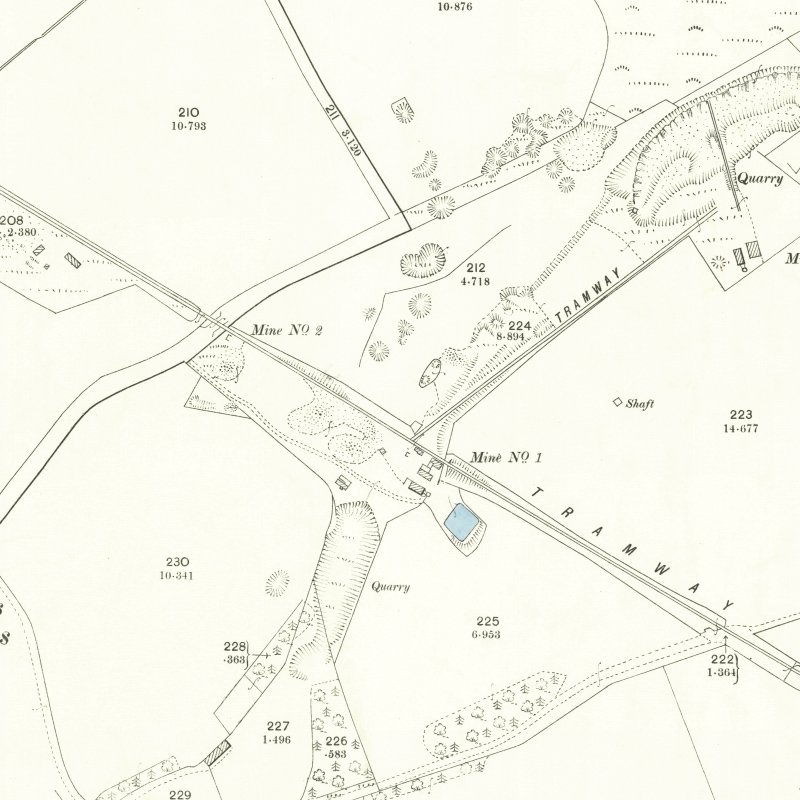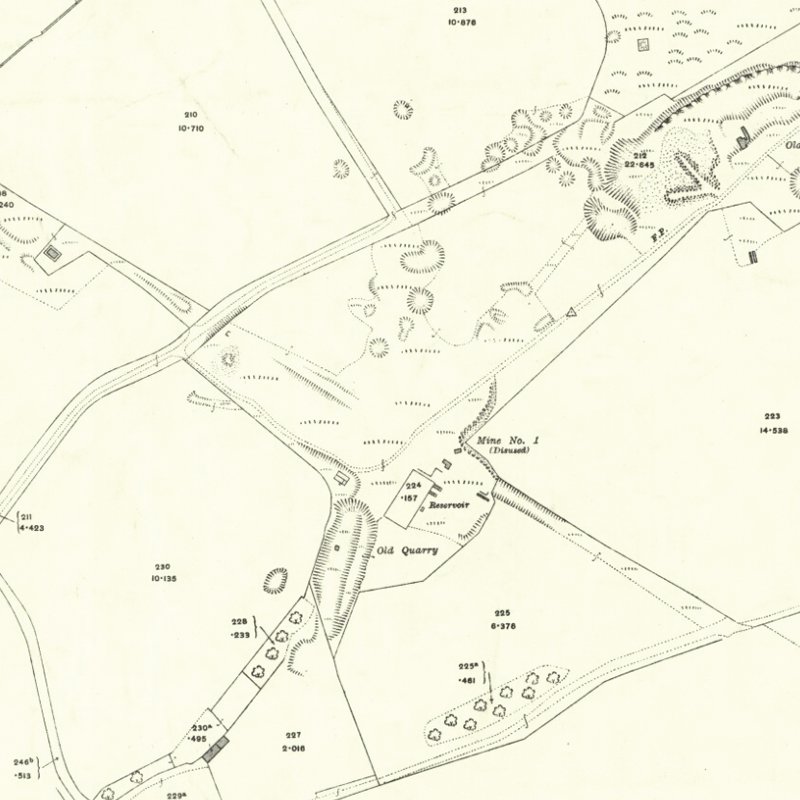- Addiewell No.1 pit
- Addiewell No.1 mine
- Addiewell No.2 pit
- Addiewell No.2 mine
- Addiewell No.3 pit
- Addiewell No.3 mine
- Addiewell No.4 pit
- Addiewell No.5 pit
- Addiewell No.6 pit
- Addiewell No.18 mine
- Albyn mine
- Alderstone No.43 mine
- Baads No.9 pit
- Baads No.15 pit
- Baads No.17 mine
- Baads No.22 pit
- Baads No.23 pit
- Baads No.42 mine
- Boghall No.1 pit
- Boghall No.2 coal pit
- Boghall No.3 pit
- Boghall No.4 pit
- Boghall "Raeburn" mine
- Breichdykes pits
- Breich No. 1 & 2 pits
- Burngrange No. 1 & 2 pits
- Burngrange No. 39 mine
- Burntisland No.1 mine
- Burntisland No.2 mine
- Burntisland No.3 mine
- Burntisland No.4 mine
- Carledubs mine
- Champfleurie mine
- Cobbinshaw No.1 & 2 mines
- Cobbinshaw No.5 mine
- Cobbinshaw South No. 1 pit
- Cobbinshaw South No.28 mine
- Cobbinshaw South No.3 mine
- Cobbinshaw (West Calder Oil) pit
- Cousland No.1 mine
- Cousland No.2 mine
- Crossgreen No.1, 2, & 3 mines
- Cuthill No.24 coal mine
- Dalmeny No.1 pit
- Dalmeny No.2 pit
- Dalmeny No.3 pit
- Dalmeny Railway No.1 & 2 mines
- Deans (Caputhall) mine
- Deans No.1 mine
- Deans No.2 mine
- Deans No.3 mine
- Deans No.3 mine & quarry (W.L.O.C.)
- Deans No.4 mine
- Deans No.4 pit
- Deans No.5 mine
- Deans No.6 mine
- Deans No.7 mine
- Drumcrosshall No1. & No.2 mines
- Drumshoreland Muir pit
- Duddingston No. 1 & 2 mines
- Duddingston No.3 mine & quarry
- Dunnet or Sandholes mine
- Dunnet's mine, East Hermand
- Easter Breich coal mine
- Easter Breich No.1 & 2 pits
- Fivestanks mine
- Fivestanks; unidentified mine
- Forkneuk No.1 & 2 pits
- Forkneuk No.38 mine
- Forkneuk No.9 & 10 pits
- Fraser pit
- Gavieside No.1 pit
- Gavieside No.2 pit
- Gavieside No.3 pit
- Gavieside No.40 mine
- Grange No.1 & 2 pits
- Grange No.3 pit
- Greendykes North mine
- Greendykes South mine
- Greenfield No.1 pit
- Greenfield No.3 mine
- Hartwood mine & coal pit
- Hayscraigs mines and quarries
- Hermand mine
- Hermand (Murray's pool) mine
- Hermand No.5 pit
- Hermand No.6 mine
- Hillend coal pit
- Holmes mine
- Hopetoun No.35 pit
- Hopetoun No.4 mine
- Hopetoun No.1 pit
- Hopetoun No.2 pit
- Hopetoun No.3 mine
- Hopetoun No.41 (Fawnspark) mine
- Hopetoun No.44 mine
- Hopetoun No.5 pit
- Hopetoun No.6 (Glendevon) mines
- Hut mines and quarry
- Ingliston No.33 pit
- Ingliston No.36 & 37 pits
- Lawhead No.1 mine
- Limefield No.32 mine
- Livingston quarries
- Mid Breich No.2 mine
- Mid Breich No.3 pit
- Mid Breich No.4 pit
- Mortonhall No.10 mine
- Mortonhall No.9 mine
- Muirhall No.16 coal mine
- Muirhall No.19 coal pit
- Newbigging No.1 & 2 mines
- Newfarm No.3 & 4 mines
- Newliston No.29 mine
- North Cobbinshaw mine
- Oakbank: Calder wood mine
- Oakbank No.1 & 2 pits
- Ochiltree Colliery - north
- Ochiltree Colliery - south
- Ochiltree No.2 mine
- Ochiltree No.3 mine
- Ochiltree No.5 mine
- Ochiltree No.6 mine
- Pentland No.1 & 2 mines
- Philpstoun No. 1 mine
- Philpstoun No. 1 (Whitequarries) mine
- Philpstoun No. 2 mine
- Philpstoun No. 3 mine
- Philpstoun No. 4 (grey) mine & quarry
- Philpstoun No. 4 mine
- Philpstoun No. 5 mine
- Philpstoun No. 6 (Whitequarries) mine
- Philpstoun No.7 mine
- Polbeth No. 8 pit
- Polbeth No.10 pit
- Polbeth No. 11 pit
- Polbeth No. 20 mine
- Polbeth No. 21 mine
- Polbeth No. 26 mine
- Polbeth No. 27 mine
- Polbeth No. 31 mine
- Polbeth No. 7 & 7½ pits
- Pumpherston No.1 mine
- Pumpherston No.2 mine
- Pumpherston No.3 mine
- Pumpherston No.4 mine
- Pumpherston No.5 mine
- Pumpherston No.6 mine
- Pyothall No.5 pit
- Redhouse No.1 coal mine
- Roman Camp (Cawburn) mine
- Roman Camp No.1 mine
- Roman Camp No.3 mine
- Roman Camp No.4 pit
- Roman Camp No.5 mine
- Roman Camp No.6 mine
- Roman Camp No.7 mine
- Roman Camp (north) No.2 mine
- Roman Camp (south) No.2 mine
- Rosshill No.1 & 2 mines
- Seafield coal mine
- Seafield No.1 mine
- Seafield No.3 mine
- Stankards No.1 pit
- Stankards No.45 mine
- Stewartfield No.1 mine
- Stewartfield No.1 pit
- Stewartfield No.2 mine
- Stewartfield No.2 pit
- Stewartfield No.3 pit
- Stewartfield No.4 pit
- Straiton No.1 & 2 mines
- Straiton No.3 pit & No.3 mine
- Straiton No.4 mine
- Straiton No.8 mine
- Strathbrock collieries
- Tarbrax No.1 pit
- Tarbrax No.2 pit
- Tottleywells No.1 mine
- Viewfield coal pit
- Viewfield No. 4 & 5 pits
- Westwood No.12 pit
- Westwood No.1 & 2 pits
- Westwood No.13 pit
- Westwood No.30 pit
- Woolfords colliery
Deans No.1 mine
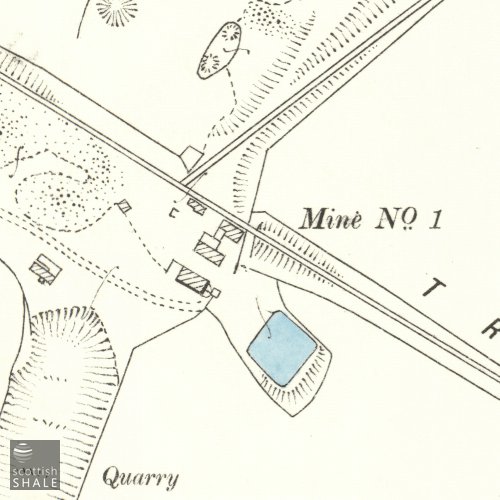
Inclined adit
Serving Deans Crude Oil Works
NOTE: There is some suggestion that "Mine No. 2" and "Mine No. 3" may have been incorrectly labelled on the 1897 O.S map, and that No. 2 should be labeled as No. 3 and visa versa. Until further evidence comes to light however, it is assumed that the labels on the OS map are correct.
The early history of the Deans mines remains unclear. Deans No. 1 exploited a number of areas of Dunnet Shale; these workings were eventually continuous with those of West Lothian Oil Company's Deans No.3 mine. Cross-cut mines also provided access to large areas of Pattison (Under Dunnet) Shale.
The Pumpherston Oil Company purchased the local mineral rights several years after the failure of the West Lothian Oil Company c.1891, and appear to have re-opened No. 1 Mine. No. 1 and No. 3 Mines were linked underground and by a surface tramway. Shale was quarried in the area between No. 1 and No. 3 Mines, and workings to the Pattison Shale and the Stanley Shale seem to have led off that quarried area.
Shale-field: Deans shale-field.
Mapped by the Ordnance Survey of c.1895, showing No. 1 Mine in operation.
Drawings
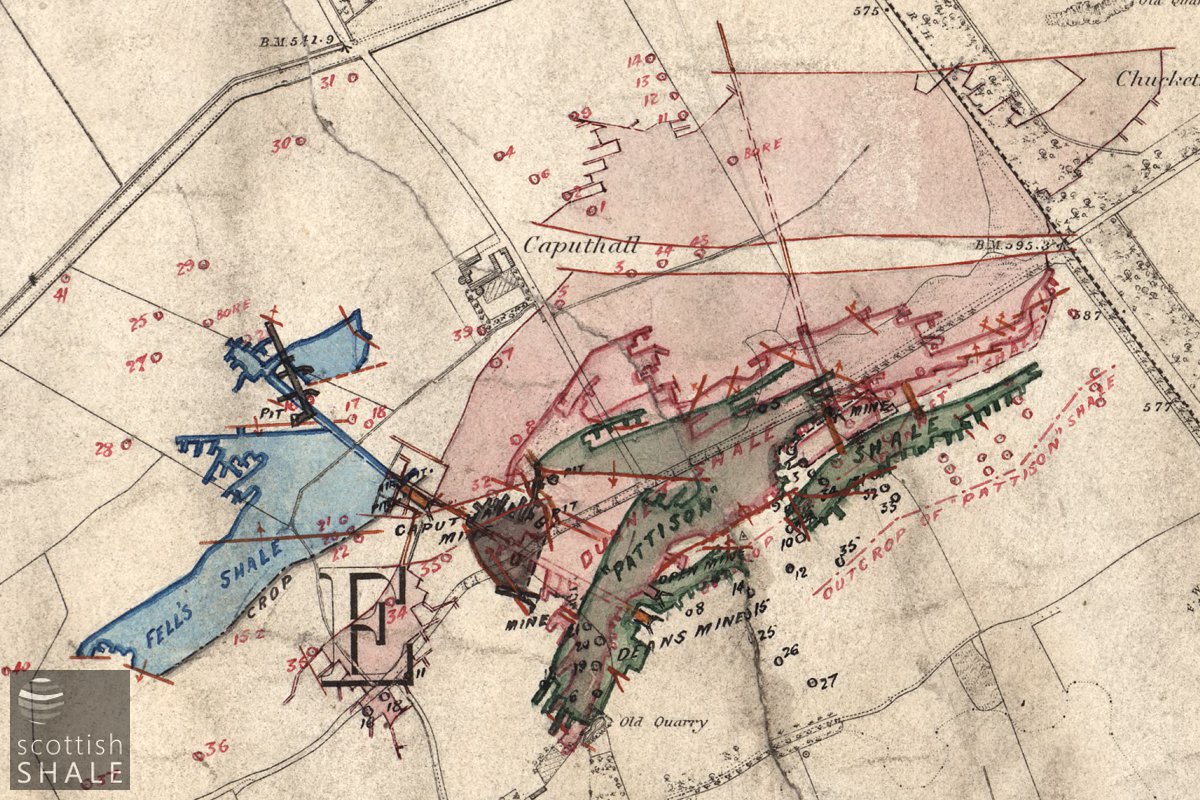
Sketch of workings in Deans area. (Courtesy, British Geological Survey LSP 974, 14992-01).

Close-up of (1) showing various mine entrances in the vicinity of Deans No. 1 mine.
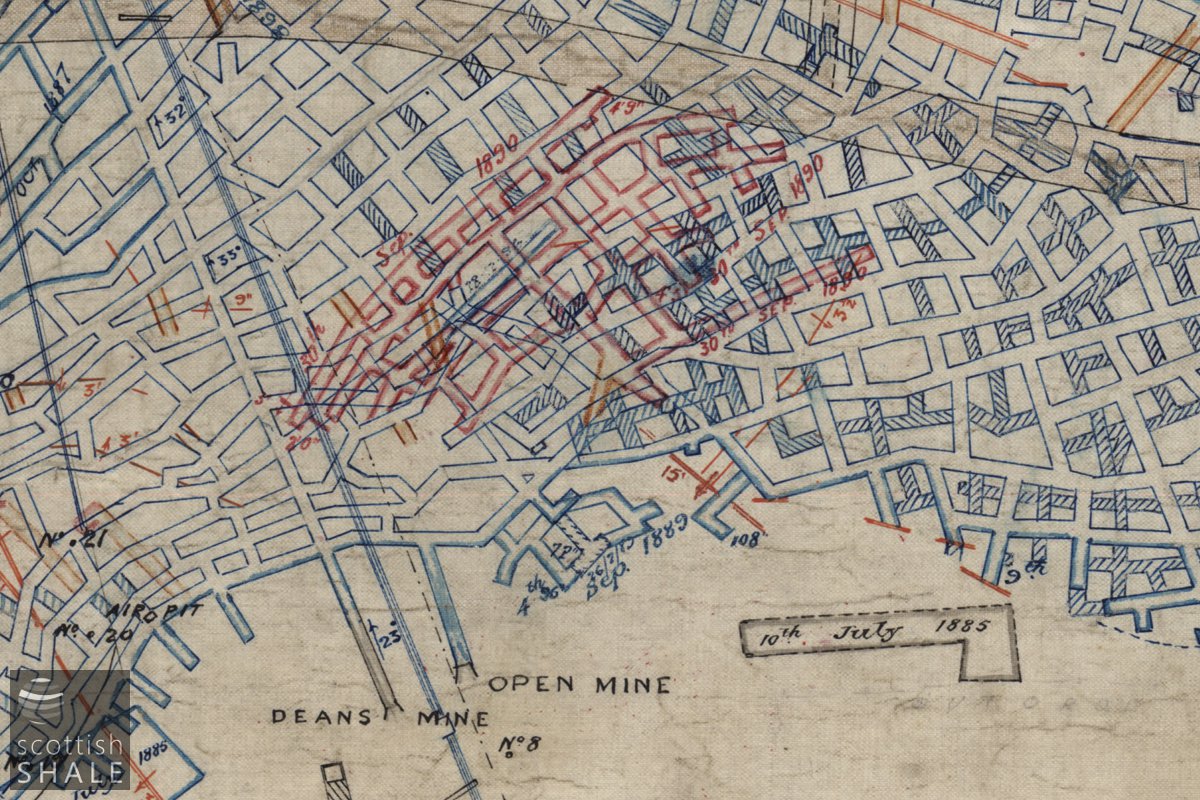
Section of plan of Dunnet shale workings showing entrance to Deans No. 1 (Courtesy, British Geological Survey, LSP 53R).
Recent images

The immediate foreground marks the approximate site of No. 1 mine. Looking east. March 2012.
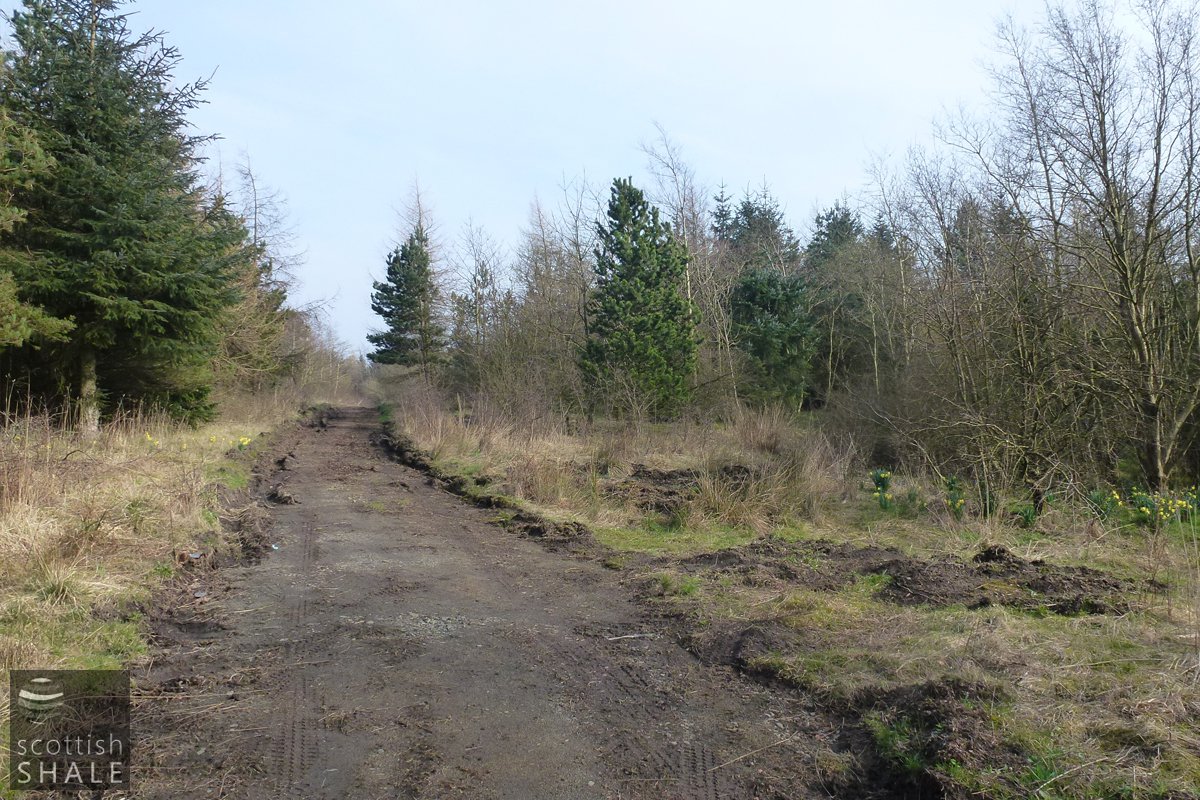
View towards the site of No. 1, from the site labelled "No. 2" on the 1896 map. The path and the overgrown hedgerow (left) mark the approximate route of the tramway, and are some the few features surviving the substantial landscaping of the area. Looking south east. March 2012.
Many… had pointed out to them with satisfaction,the open quarry, where they had, so to speak, a bing of shale that would keep them going for years. Had they wrought that quarry alone, which they could easily have done at that time, they would have saved in the meantime a large amount of capital expenditure, but this would not have been fair for the future of the company. What they had been anxious about, and what they had done had to be to develop the two mines that they had opened out to the Dunnet and Fells seams.
First AGM of the West Lothian Oil Company Ltd reported in Glasgow Herald, 7th February 1885
.......
...a fresh seam of shale (the "Barrack") has been successfully opened into, greatly superior to any shale hitherto obtained on the property, yielding, per ton, much more oil, which is finer in quality, richer in scale, and produces greatly more sulphate of ammonia, which this special and unusual advantage, that it is brought to the surface by one of the existing mines. Further, an outcrop of "Dunnet" shale, of great thickness and excellent quality, in still better condition in the mine, has been opened up, which is capable of yielding a large supply by open cast or quarrying, at a much lower rate of cost than anything hitherto known.
AGM of West Lothian Oil Company Ltd, The Scotsman, 27th September 1886
.......
Their mines were in good order, and they were opening up a new mine which would help to keep their shale at a moderate cost. The new mine was in the side of the quarry, and was a specially valuable part of the present properties, and thus lessening the cost of drawing; and it likewise opened up a great field of shale about 18 feet in thickness. The extra cost of this new mine would be small.
Fifth AGM of West Lothian Oil Company Ltd, The Scotsman, 12th June 1889
Coal Authority Mine Abandonment Catalogue No. 4940, showing workings in the Stanley, Dunnet and Pattison Shales from Deans No. 1, No. 2, Caputhall, abandoned in 1906.


